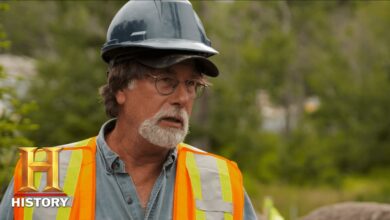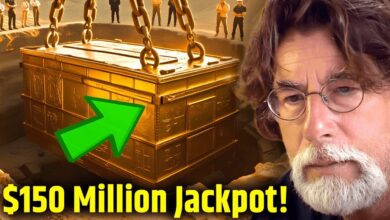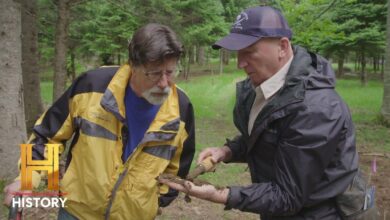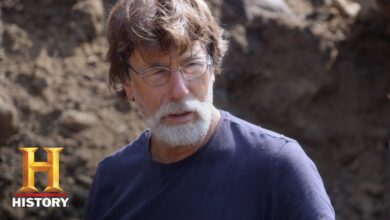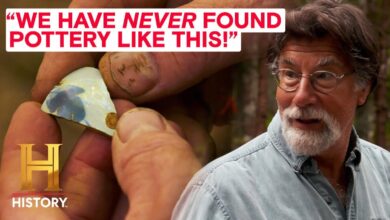The Curse of Oak Island: Season 12 EP#1..
The Curse of Oak Island: Season 12 EP#1..

Season 12 Premiere Episode 1: The New Digs – Artifact and Feature Analysis by the Oak Island Compendium
In this week’s episode, The New Digs, we are first taken to The Money Pit area, where the Oak Island team believes that they have discovered the location of Shaft 2, which was dug by the Onslow Company in 1805. Its purpose was to bypass the original shaft and connect to The Money Pit.
When trying to connect to The Money Pit, the diggers struck water, and the shaft was flooded out and abandoned. The Oak Island team is hoping to get wood samples for dendrochronology testing to confirm this is the same shaft. This was called the “Holy Grail of shafts” besides The Money Pit by Rick Lagina because it would be roughly 14 ft from the original Money Pit location. The team would like to find that location and explore it further. It seems this endeavor will be taking the place of the Garden Shaft from last season.
We are then taken to Lot 15, where the Oak Island archaeologists are working to excavate the areas under the stone canes, or “pirate piles,” as Fred Nolan called them. Nolan originally found the formations in the 1960s.
As the team is excavating, they discover pieces of slate around a possible structure, and at depth in this area, the team ponders what this could mean. It should be noted that crushed slate was found on Lot 5 last season, and the Compendium reported that this was used in the production of bricks, which we believe was one of the industrial operations that was going on at one time on Oak Island.
The team continued to work in the area, then the action shifted to Shaft 2 in The Money Pit area, where the Oak Island team continued the excavation. They are shown using a mirror with reflected light to see into the shaft and visualize the surrounding area of what they are digging.
As the spoils were brought up, Gary Drayton started to metal detect the spoils. Gary had a hit on his metal detector and found a rose head spike. Drayton estimated the date was around the 1700s or earlier. If this is accurate, it would not match Shaft 2, which was dug in 1805, although the team stated they believed it was Shaft 2. The spike was bagged and tagged and sent off to Emma at the lab for testing.
Then the scene took us to Borehole DN7, which is in the new area of interest called “The Pie,” which also surrounds the Baby Blob. This is where high concentrations of gold and silver have been detected in the water in the ground. A core drill was set up and operation began. The drilling reached a depth of 120 ft. The core sample revealed that it was soft clay material that was wet. The drill also encountered an air pocket at a depth of 10–12 ft.
It was speculated that perhaps this was a man-made flood tunnel, but more exploration is necessary to know for sure. There was also speculation of a side chamber.
As the team continued its work, we were then taken back to Lot 15, where geoscientist Dr. Spooner arrived at the scene to render his opinion of what they were encountering at the site. He mentioned the slate found in the excavation and the fact there was till in the structure. It was mentioned that there are two different types of bedrock on the island: limestone in the east and slate in the west. This specific area does not have naturally occurring slate and could have been brought from Lot 5 or somewhere else on the western part of the island.
He also noted some similarities in construction between the cans and the wall and well found on Lot 26. It was also speculated that these mounds were built by the Templars, based on a theory by Dr. Gaspar. It should be noted that Dr. Gaspar’s theory has some concerns with its methodology and should be taken with a degree of caution.
The action then took us to Shaft 2 in The Money Pit area, where the team continued to excavate what they believed was Shaft 2, originally dug by the Onslow Company. They found one part of a wall and were looking for the parallel wall during the excavation. Rick Lagina found what appeared to be a dowel in the spoils. This reminded him of the dowels used in the U-shaped structure at Smith’s Cove that the team previously investigated.
As they continued, they did not find another wall until they were 17 ft away from the first wall. This led to speculation that they have two separate shafts in close proximity. The team was looking to go down to 30–40 ft to get wood samples for testing.
The scene then shifted to the lab, where archaeometallurgist Emma Culligan and archaeologist MOA McDonald met with the team to give results on some testing that was conducted on three types of soil samples. The samples originated from The Money Pit area, the conglomerate from under Cone E, and from the circular depression on Lot 5.
The samples concluded that they were over 90% matching, and that some sort of operation was going on that involved the three sites at one time. It was speculated that it was perhaps during a treasure deposit scenario, but it is more likely it was from an industrial operation like mining and the production of bricks. In this writer’s opinion, Marty was very intrigued by the results and said that they wanted to lift Cone E and check for more materials that may be buried beneath it.
We were then taken back to the area now known as Shaft 2A. It is noted that this shaft appears to have been undocumented and is about halfway between what may be Shaft 2 and the Garden Shaft. The team wants to get some wood samples at depth to get a date of the construction. Rick notices that the bucket of the excavator is bouncing around, which indicates that the material is hard and dense. The team ponders if it is an original construction and something was hidden there.
The team takes a measurement of the shaft, and it appears it is about 9–10 ft long, which was the same dimension as the Garden Shaft. This newly discovered unrecorded shaft is about 30 ft from the Garden Shaft.
The action then moves to Lot 4, where Gary Drayton and Peter Fetti are searching the spoils from the Lot 5 dig of the circular feature. It is estimated that 10 tons of spoils are deposited in this location. Gary begins his work and detects something—he uncovers a cut coin. Gary postulates that it is Spanish and silver. Gary mentioned this would have been cut to make change, and it was a piece of treasure.
It is then explained that trade routes opened up in the New World and perhaps this involved pirate treasure. The piece was bagged and tagged and sent to Emma in the lab for testing.
We are then taken to the lab, where archaeologist L. Nen and archaeometallurgist Emma Culligan are analyzing the cut coin found by Gary Drayton and Peter Fetti on Lot 4. L. Nen inspects the coin and mentions it is perfectly cut and quartered. Emma suggests scanning the coin with XRF to reveal more details. Emma states that the coin has the presence of chlorine in it, which indicates it has been in saltwater for a period of time. It is verified to be silver, which then launches the William Fips Theory regarding Oak Island.
It is again theorized that Fips buried treasure on Oak Island, and his associate Andrew Belcher buried silver from the shipwreck of the Conception. Emma then does a CT scan of the coin but could not find any identifying marks. She mentions that she will do a deeper scan to see if she can uncover any details.
The next scene brought us to Cone, where the team has made plans to lift up the boulder and dig underneath it to see what could be discovered. It was in this spot that Marty Lagina found the conglomerate, which had the animal hair in it. A 30-ton crane is brought in to lift the boulder.
Upon inspection, the team finds what appears to be more of this conglomerate that was previously found. Dr. Spooner inspects the material and remarks that it is exactly the same material as the previously discovered sample. He mentions that there are sticks and red moss underneath the boulder, and it appears that someone was digging here before the boulder was put into place. It is also mentioned that Fred Nolan was digging around this boulder but claimed he never moved it. The team will investigate the area further.
We are then taken back to Shaft 2A, where the team has made considerable progress in uncovering this shaft. The definition of the shaft is revealed, and it is remarked that it is identical to the Garden Shaft. The team is baffled by why there would be two unrecorded shafts so close together. Marty remarks that the shaft was filled in very well, and whoever dug it went to great pains to cover it up and hide it.
It is mentioned that this was deliberately done, so the team will continue to work in this area to find some good wood samples at depth for dating. The team then assembles at the War Room to hear the results of the testing of the cut coin from Emma Culligan. Emma explains that it was almost impossible to see any detail on the coin. She was able to use deep scanning to get some faint details. She also mentions that there is some lead to its composition. Emma shows that the coin reveals “GV.” She further states that after researching, she believes it is a William III English Shilling from 1697.
Emma has consistently demonstrated that she is the MVP of the team in this writer’s opinion based on her outstanding work.
It is then stated that Graham Harris and Les MC had a theory that the British military were on Oak Island looking for William Fips’ treasure that was theoretically buried there. Although this coin does not substantiate that theory, the mentioning of this theory seems like a pivot to get off the fact that the coin was thought to be Spanish but is English, thus excluding it from being a part of the Conception treasure.
There are problems with the Fips-Belcher treasure theory. Commentary history reveals that during the time that Fips and Belcher would have supposedly buried treasure on Oak Island, the area was controlled by the French. French pirates were based in LaHave in the late 1600s to early 1700s, not too far from Mahone Bay. It would have been highly dangerous and unwise to attempt to hide any kind of treasure by an Englishman in an area like Oak Island at the time.
It appears that Andrew Belcher, Fips’ associate, was in Mahone Bay and very likely involved with Oak Island. The reason for this seems clear: Belcher was a merchant, slave trader, and unscrupulous character. He had been accused of illegal trading during his career, and it seems most probable that he was engaged in illegal trading on Oak Island. Evidence like cut coins, trade weights, etc., points to trade operations between French and British interests on the island during this time.
Belcher was trading with the French, among others, and allowed to pass into the area because of his status as a Freemason and considerable business connections. Belcher was so unscrupulous that he once traded flour that was in urgent need in his home area to outside of it so he could turn a large profit.
The Fips-Belcher treasure theory is not supported by the real history of the area but makes for an entertaining story.
The episode concluded back at Shaft 2A. The team, after continuing efforts, was able to find some excellent wood samples that will be sent out for dendrochronology testing to get a possible date of the construction. A very large beam was discovered; Gary checked for metal, but there was no metal detected. The team was still uncertain why these undocumented shafts were in such close proximity to each other, and the work will be paused there until the data comes back.
Commentary: In this writer’s opinion, there is an explanation for the close proximity of the shafts and a reason why they were undocumented. It seems that these shafts weren’t searcher shafts but they were mining shafts that predated 1795.
It’s not a coincidence, in this writer’s opinion, that these shafts are located in an area close to high concentrations of gold. Compendium investigations believe that mining was being conducted in this area and was very secretive. It is very common to find old mining shafts close to each other. Many underground mines have multiple shafts, and it seems likely that was the reason for this setup on Oak Island. After the mines were abandoned, they were backfilled with soil, rubble, and mine waste and capped with wood. It’s believed by this writer that is exactly what has been found at the Garden Shaft and Shaft 2A.
Please follow our weekly episode analyses during the season, along with our Throwback Thursday articles from the original Compendium Blockhouse blog and special investigations and features involving Oak Island. Feel free to reach out to us for questions, comments, information, and any theories at our email: [email protected].
Please visit www.theoakislandcompendium.com for this article and our other content related to the Oak Island mystery.
Good day from the Compendium,
Daniel and Charlotte




